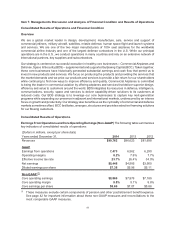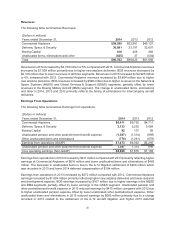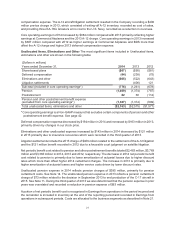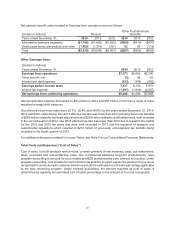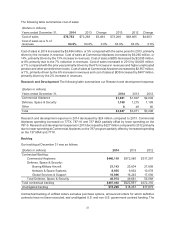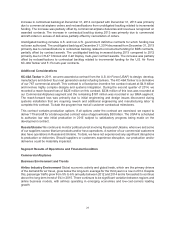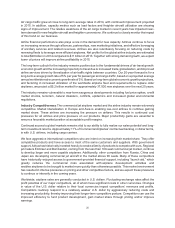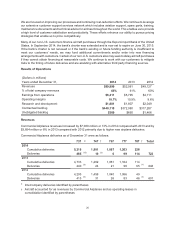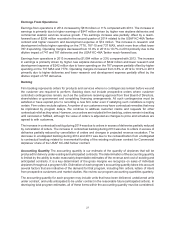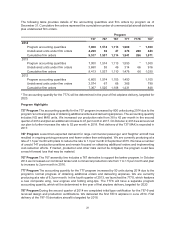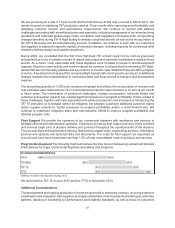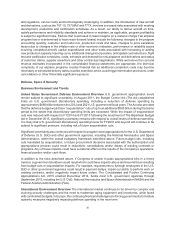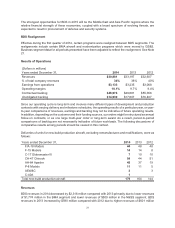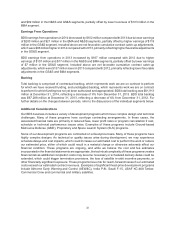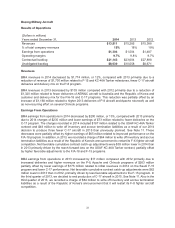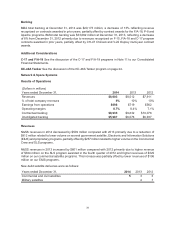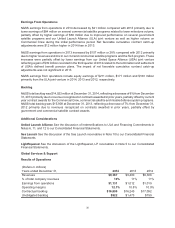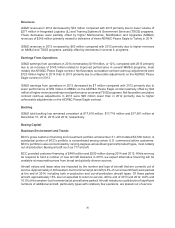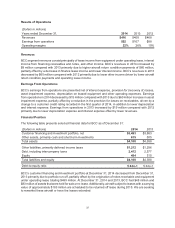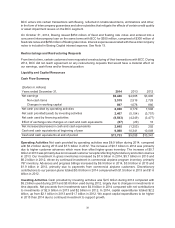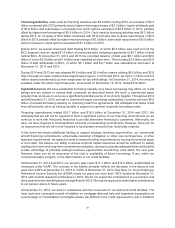Boeing 2014 Annual Report Download - page 41
Download and view the complete annual report
Please find page 41 of the 2014 Boeing annual report below. You can navigate through the pages in the report by either clicking on the pages listed below, or by using the keyword search tool below to find specific information within the annual report.
29
We are producing at a rate of 10 per month and the first delivery at this rate occurred in March 2014. We
remain focused on stabilizing 787 production rates at 10 per month while improving aircraft reliability and
satisfying customer mission and performance requirements. We continue to monitor and address
challenges associated with aircraft production and assembly, including management of our manufacturing
operations and extended global supply chain, completion and integration of traveled work, incorporating
changes identified during 787-8 flight testing to already completed aircraft, as well as the incorporation of
the 787-9 derivative into the manufacturing process. In addition, we continue to work with our customers
and suppliers to assess the specific impacts of schedule changes, including requests for contractual relief
related to delivery delays and supplier assertions.
During 2009, we concluded that the first three flight-test 787 aircraft could not be sold as previously
anticipated due to the inordinate amount of rework and unique and extensive modifications made to those
aircraft. As a result, costs associated with these airplanes were included in research and development
expense. Based on sales activity and market interest we continue to believe that the remaining 787 flight-
test aircraft are commercially saleable and we continue to include costs related to these aircraft in program
inventory. If we determine that any of the remaining flight-test aircraft cannot be sold, we may incur additional
charges related to the reclassification of costs associated with those aircraft to research and development
expense.
The accounting quantity of 1,300 units remains unchanged and reflects the incorporation of revenue and
cost estimates associated with the 787-10 and planned production rate increases to 12 and 14 per month
in future years. The combination of production challenges, change incorporation, schedule delays and
customer and supplier impacts has created significant pressure on program profitability. If risks related to
these challenges, together with risks associated with planned production rate increases or introducing the
787-10 derivative as scheduled cannot be mitigated, the program could face additional customer claims
and/or supplier assertions, further pressures on program profitability and/or a reach-forward loss. We
continue to implement mitigation plans and cost-reduction efforts to improve program profitability and
address program risks.
Fleet Support We provide the operators of our commercial airplanes with assistance and services to
facilitate efficient and safe airplane operation. Collectively known as fleet support services, these activities
and services begin prior to airplane delivery and continue throughout the operational life of the airplane.
They include flight and maintenance training, field service support costs, engineering services, information
services and systems and technical data and documents. The costs for fleet support are expensed as
incurred and have been historically less than 1.5% of total consolidated costs of products and services.
Program Development The following chart summarizes the time horizon between go-ahead and planned
initial delivery for major Commercial Airplanes derivatives and programs.
Reflects models in development during 2014
We launched the 787-10 in June 2013 and the 777X in November 2013.
Additional Considerations
The development and ongoing production of commercial aircraft is extremely complex, involving extensive
coordination and integration with suppliers and highly-skilled labor from thousands of employees and other
partners. Meeting or exceeding our performance and reliability standards, as well as those of customers


